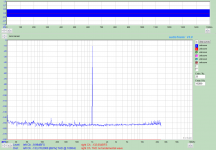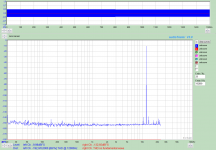There are ventilation holes, but no fan. There are also ventilation holes in the bottom part. So I did adhere to design goal no.6 in the first post 🙂
Hi JensH, i remember the board has provision for mounting a EMI shielding/cage around the input amplifier. Does the final product have them? Just curious.
I have not used them and I have not seen any issues. So I don't plan to include them in the final product.
I think Chris' comments above are most relevant.
As far as I know there is no cooling fan fitted.
My general experience with product design has been that if the packaging and shielding has been designed correctly EMI is less likely to be a problem, and measured performance if anything would improve.
As far as I know there is no cooling fan fitted.
My general experience with product design has been that if the packaging and shielding has been designed correctly EMI is less likely to be a problem, and measured performance if anything would improve.
I don't have a specification of the jitter. I use two very low phase noise crystal oscillators from this series:
NZ2520SD(OA / AV)/Crystal Clock Oscillators/NDK
These are located between the ADC and the DAC, with short connections to both.
I don't have access to test equipment that can verify this low level of jitter though.
Measuring jitter of the crystal source is a nice to have. Measuring the impact of the jitter on the source side is pretty straightforward and more important. A Jtest type signal (FS/4) to a high res FFT and look for sidebands. I doubt any of significance would show up. For the ADC jitter shows as an increased noise floor.
Either ADC or DAC measurements so far would have shown a problem and would have been addressed already.
Yes it does.
@DigiAudioCon
The AK4492 does indeed look like an interesting alternative. It will not make it into the first version though.
I have looked at bit at the AK4497, but I have not reached a final conclusion yet.
Hi JensH,
Anything new regarding using AK4497?
It would be great to replace AK4490 with AK4497 if the THD and noise can be further improved. 🙂
Hello Jens
Which audio analyzer software do you prefer for using with your RTX?
Kind regards
Phil
Which audio analyzer software do you prefer for using with your RTX?
Kind regards
Phil
@PaulBC
I haven't had much time to look at the AK4497 lately. According to the data sheet it should be an improvement over the AK4490. The dynamic range is definitely higher. I still need to verify the distortion.
@Philipp23
I normally use audioTester, but I have also used Arta and Steps for some measurements, which audioTester cannot do.
I haven't had much time to look at the AK4497 lately. According to the data sheet it should be an improvement over the AK4490. The dynamic range is definitely higher. I still need to verify the distortion.
@Philipp23
I normally use audioTester, but I have also used Arta and Steps for some measurements, which audioTester cannot do.
I'll wait for the software end 'till the equipment shows up. You never know what platform will be considered the least of a PITA to work with either.
Just upgraded Fedora 24 (buggy on that computer) to 25 workstation. So far, huge improvement. Maybe it just didn't like the hardware (although the Lenovo machines have been some of the best I've used).
-Chris
Just upgraded Fedora 24 (buggy on that computer) to 25 workstation. So far, huge improvement. Maybe it just didn't like the hardware (although the Lenovo machines have been some of the best I've used).
-Chris
@PaulBC
I haven't had much time to look at the AK4497 lately. According to the data sheet it should be an improvement over the AK4490. The dynamic range is definitely higher. I still need to verify the distortion.
Thanks for your great efforts, JensH.
I'll wait for the software end 'till the equipment shows up. You never know what platform will be considered the least of a PITA to work with either.
-Chris
Chris no need to wait; the software end will not work differently than it works with whatever is your current sound card. So you can start training right now 🙂
Jan
Measuring jitter of the crystal source is a nice to have. Measuring the impact of the jitter on the source side is pretty straightforward and more important. A Jtest type signal (FS/4) to a high res FFT and look for sidebands. I doubt any of significance would show up. For the ADC jitter shows as an increased noise floor.
Either ADC or DAC measurements so far would have shown a problem and would have been addressed already.
Unless these measurements were performed by loopback with the same device ... as then ADC and DAC are commonly clocked.
I agree that having a common clock may blur the picture.
I just made a couple of measurements, using two analyzers, one as generator and one as analyzer.
I measured the FFT with signals at 1 kHz and 12 kHz. I did not use a JTEST signal. I am not quite sure whether the JTEST signal makes sense in this case, since there is no clock regeneration.
The noise spikes at the high end of the frequency spectrum are generated by the DAC. They change depending on the input frequency and the level, but I don't think they are related to jitter. They are most likely a product of the delta-sigma process.
I just made a couple of measurements, using two analyzers, one as generator and one as analyzer.
I measured the FFT with signals at 1 kHz and 12 kHz. I did not use a JTEST signal. I am not quite sure whether the JTEST signal makes sense in this case, since there is no clock regeneration.
The noise spikes at the high end of the frequency spectrum are generated by the DAC. They change depending on the input frequency and the level, but I don't think they are related to jitter. They are most likely a product of the delta-sigma process.
Attachments
@PaulBC
I haven't had much time to look at the AK4497 lately. According to the data sheet it should be an improvement over the AK4490. The dynamic range is definitely higher. I still need to verify the distortion.
I wouldn't mind waiting longer for a better performing unit 😉
Hi Jan,
Yes, but this way my mind is on the job in one go.
My computer was just hit with a nasty trojan and it looks like I lost everything. I'd rather wait until the audio analyser is ready, who knows what computer I'll be using then. I'll probably dedicate a machine to the bench equipment anyway.
-Chris
Yes, but this way my mind is on the job in one go.
My computer was just hit with a nasty trojan and it looks like I lost everything. I'd rather wait until the audio analyser is ready, who knows what computer I'll be using then. I'll probably dedicate a machine to the bench equipment anyway.
-Chris
Hi Jan,
Yes, but this way my mind is on the job in one go.
My computer was just hit with a nasty trojan and it looks like I lost everything. I'd rather wait until the audio analyser is ready, who knows what computer I'll be using then. I'll probably dedicate a machine to the bench equipment anyway.
-Chris
A dedicated PC is a good idea. Especially as it does not need to be a super fast/large memory unit. Audio and measurement tasks don't even stress an ancient '486 - remember those ;-)
A dedicated PC is a good idea. Especially as it does not need to be a super fast/large memory unit. Audio and measurement tasks don't even stress an ancient '486 - remember those ;-)
My 1.2GHz Core2Duo Windows 7 notebook (6 years old, with 6GB RAM) doesn't seem to be fast enough when running 128k bin size FFT with 32bit/192kHz samples 😕
- Home
- Design & Build
- Equipment & Tools
- DIY Audio Analyzer with AK5397/AK5394A and AK4490

